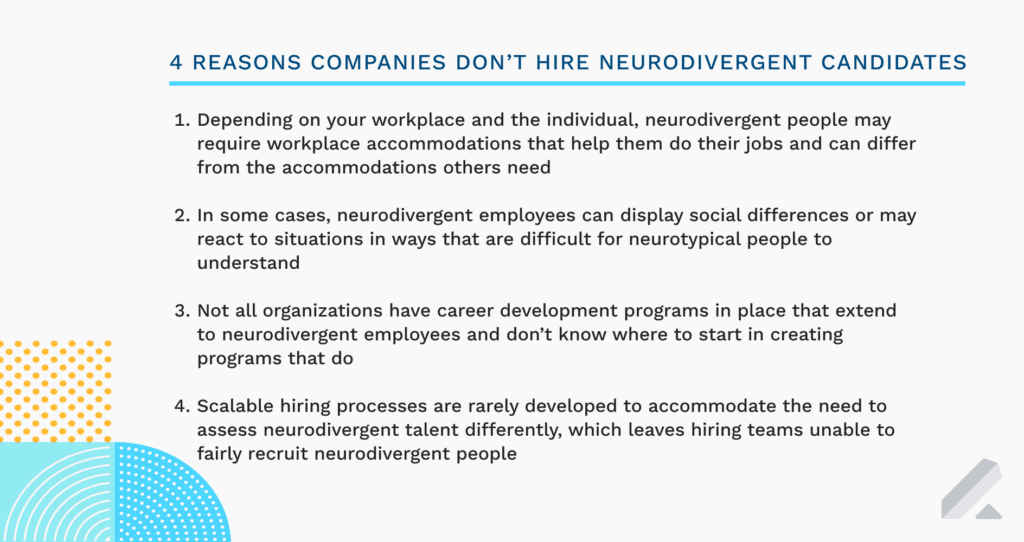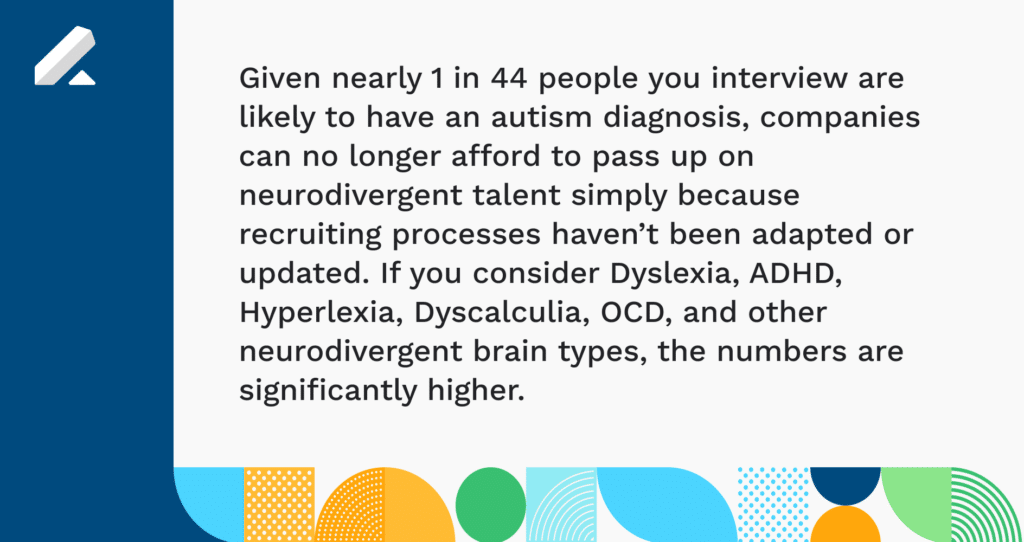Studies have shown that despite the many benefits organizations can reap from working with neurodivergent talent, these individuals continue to be overlooked in favor of neurotypical candidates and better ‘culture fits.’ In the UK, for example, just 22% of autistic adults are employed, while roughly 85% of autistic university graduates in the US have been unemployed.
In bypassing neurodivergent talent, organizations are giving up significant opportunities to not only educate their company on neurodiversity but also hire and retain talent that can drive innovation in their business through visual and creative thinking, fine detail processing, analytical skillsets, sequencing, and much more.
This is where recruiters and hiring teams can have a sizeable and tangible impact on business objectives—all while driving diversity, equity, and inclusion (DEI) within their organizations. However, recruiting for neurodiversity can be nuanced and requires hiring teams to do both strategic and tactical work to improve their recruiting process.
In this article, we’re going to break down what neurodiversity is, why you should be hiring for neurodiversity, and 4 simple ways you can optimize your hiring practices to drive neurodiversity in your organization.
What is neurodiversity?
‘Neurodiversity’ is a relatively new term that refers to autistic people (ASD), dyslexia, dyspraxia, ADHD, and other neurological conditions. These include ‘spectrum conditions’ with a wide range of characteristics.
Many neurodivergent people have extraordinary subsets of skills, including skills in mathematics, art, analysis, pattern recognition, and more.
“Our strengths and weaknesses are often less common than those in the general population, bringing our diverse ways of thinking, experiencing, and processing information (and the world around us) to help round out a team. We approach problems differently because of our varied perspectives and may see things others miss,” says Lyric Holmans, Organizational Change Agent and Educator with NeuroDivergent Consulting.
And yet, many organizations fail to understand neurodivergent talent, as neurodivergent people can struggle to fit the ‘mold’ or ‘profile’ sought by employers for open roles.
Neurodivergent vs. neurotypical
If we think of neurodiversity as an ‘umbrella,’ then people typically fall into one of two categories: neurodivergent or neurotypical.
Those considered ‘neurotypical’ are often described as having standard or typical brain processing and behaviors that are considered compatible with the society and culture in which we live. In the past, neurotypical people would have been labeled as ‘normal’ in comparison to neurodivergent individuals.
Being neurotypical is rooted in the idea that, because your brain works in much the same way as other people’s do, you needn’t think about how your brain functions or how your behaviors manifest as a result of it.
Neurotypical standards, goals, and expectations are often projected onto neurodivergent people, which can set them up for failure. Neurotypicalness isn’t the default for humanity—it’s just what we’ve come to know mostly through our dominant culture.
However, ‘neurodivergent’ people are often made aware that their brains function differently. For neurodivergent people, the brain has one or more ways of functioning that are considered outside of the ‘typical’ way a brain functions.
For example, OCD, ASD, dyspraxia, and Tourettes are common neurological conditions that neurodivergent people can be diagnosed with.
Neurodiversity advocates for embracing these differences rather than trying to ‘fix’ or ‘cure’ them, recognizing that thinking or behaving differently can be beneficial to both people and businesses and that assuming there are ‘normal’ versus ‘abnormal’ ways of functioning limits us as individuals and organizations.
Why you should recruit for neurodiversity
There are many advantages to recruiting neurodivergent people, just as there are benefits to diversity recruiting for race, gender, and more. However, many organizations will shy away from recruiting for neurodiversity due to a lack of understanding about neurodivergent talent and the many ways in which hiring practices can be modified to accommodate them.
Above and beyond factors like the Great Resignation, Great Rehire, and major skill gaps afflicting companies globally, neurodivergent people can bring a wealth of unique skills, perspectives, and experiences to your workplace that benefit both the business and other team members overall.
Some of the top reasons companies large and small are prioritizing the recruitment of neurodivergent people include:
- Adoption of new, sophisticated technologies (think: AI and VR) along with data-driven processes.
- Changing business innovation in SaaS, Tech, and Bioindustries, where analytical skills are in high demand.
- The shortage of talent in STEM (science, technology, engineering, and math)
- The need for more employees who are skilled in areas such as pattern. recognition, information processing, mathematics, machine learning, analytics, and more.
- Making workplaces more inclusive for neurodivergent people also makes workplaces better for everyone within an organization.
As companies work towards hiring more neurodivergent talent, there will be an increasing need for hiring teams and talent acquisition leaders to rethink how they recruit and optimize their hiring practices to be inclusive of both mental and physical diversity.
Given nearly 1 in 44 people you interview are likely to have an autism diagnosis, companies can no longer afford to pass up on neurodivergent talent simply because recruiting processes haven’t been adapted or updated. If you consider Dyslexia, ADHD, Hyperlexia, Dyscalculia, OCD, and other neurodivergent brain types, the numbers are significantly higher.
There are many advantages of having a neurodiverse workforce, but let’s look at the top ones your organization could benefit from:
- Unique skills and capabilities that benefit organizations in need of STEM, creative, and rule-based thinking
- Strong analytical skills that help businesses identify inefficiencies and strengthen areas of improvement
- Higher level of innovation and creativity among several different teams (from marketing to engineering and beyond)
- Better, more inclusive recruiting processes that drive diversity through more objective, equitable hiring practices
- Tapping into top talent that is often ignored by other companies, including your competitors
- Company-wide communication improves as managers and leaders adopt clearer methods of communicating otherwise abstract ideas
4 tips for hiring for neurodiversity
To build a neurodiverse workplace, we first need to understand that ‘neurodiverse’ and neurodiversity both encompass everyone. Much like diversity applies to a wide variety of backgrounds, experiences, and perspectives, neurodiversity points to the range of differences in our brain functions and behaviors. With neurodiversity, we regard these differences as being part of the normal variations found in who we are as human beings.
How do you foster a neurodiverse workplace, though? How can recruiters, hiring managers, and talent acquisition teams make it so that their workplaces are built on neurodiversity from the ground up?
There are 4 key ways your hiring team can contribute to fostering a neurodiverse workplace:
- Create inclusive recruiting practices
- Optimize your DEI initiatives to include neurodiversity
- Train your hiring team on recruiting neurodivergent talent
- Leverage universal design
Create inclusive recruiting practices
This may seem like the obvious first step, but in order to create inclusive recruiting practices, you’ll need to ensure that your team:
- Understands why you’re hiring for the roles you are, and the impact they’ll have on the business;
- Acknowledges gaps in your recruiting practices that include some minority groups but exclude others;
- Is aware of where you source candidates and which channels provide the most ROI when sourcing diverse talent;
- Leverages data and insights from past recruiting initiatives so determine where your team is falling short of driving diversity in its hiring.
Optimize your DEI initiatives to include neurodiversity
Many DEI initiatives can be exclusive of neurodivergent talent even if they’re inclusive of a diversity of race, gender, thought, ethnicity, and other factors. To aid your DEI initiatives in being inclusive of neurodiversity as well, think about how you hire.
Are your recruiting practices:
- Objective, fair, and standardized?
- Inclusive of diverse stakeholders?
- Accommodating of different needs (both disability and non-disability)?
In other words, recruiting is just as much a part of your ongoing DEI initiatives as ERGs, activities, compensation benchmarks, and more.
Train your hiring team on recruiting neurodivergent talent
It’s never too late to provide neurodiversity training for your recruiters and hiring managers just as you might diversity training.
For example, you can organize professional training sessions for hiring teams as well as your entire organization that help employees recognize neurodiversity and learn how to work alongside neurodivergent talent within your company. Training like this isn’t just for recruiters—it should apply to everyone involved, but especially managers and those in senior leadership roles who oversee teams and guide inter-team communication.
Leverage universal design
In a nutshell, universal design drives equality in your workplace by ensuring people make decisions that benefit everyone, not just one or a few people. Let’s say, for example, that your leadership team wants to hire a coach to educate your company on your neurodiversity.
By hiring an autistic neurodiversity expert to coach your entire company, as opposed to hiring a coach to teach only neurodivergent employees, you’d be leveraging universal design.
Tips for making Universal Design work:
- Make every decision helpful to everyone, not just one person
- Put systems in place that allow for open communication
- Assign an ambassador to each new hire
- Offer learning and development for individual career paths
Attract, hire, and retain neurodivergent talent with our Recruiter Guide
In a world where more organizations are celebrating diversity in many of its forms, neurodivergent talent continues to be overlooked despite the many benefits of working with neurodivergent people. However, as with all diversity, equity, and inclusion efforts, hiring for neurodiversity is not a one-and-done initiative. It requires a stringent commitment to making measurable improvements in how you hire and practice diversity recruiting.
To support your hiring team in building stronger partnerships with hiring managers to recruit and retain neurodivergent talent, download your free copy of our Neurodiversity Recruiting Guide!
 Talent Relationship Management, Explained: A Guide for Recruiters
Talent Relationship Management, Explained: A Guide for Recruiters
 For the third quarter in a row, Lever has won two Comparably awards!
For the third quarter in a row, Lever has won two Comparably awards!


